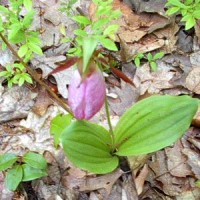
Put yourself in in your customers shoes. What do they have now. Where do they want to go or get to in their gardens.
That’s why I put this lady slipper in this blog. It doesn’t come from my local growers. It is naturally growing in my woods. I was pondering what to do in my own gardens this year because I need to do a COMPLETE overhaul of my WHOLE yard! I know that this is a huge endeavor.
I was thinking of one of the yards about 10 houses down from me (about a mile away). A couple of years ago these folks had a yard just like everyone else. Then they had some landscaping crews come out and basically scrape the earth from around the trees (many of which they removed – about half of those trees) and replaced the pine needles and natural plants with new loam and grass with a few plants like hostas and azaleas and not much else. It looks very clean and bright.
I was thinking of how many native species they wiped out when they took everything out. I would miss these lady slippers and other little native orchids, Solomon Seals, lily of the valley, partridge berry, wintergreen, low bush blueberries, Christmas ferns, blue flag, Indian cucumbers, columbine, and so much more. I really believe that folks don’t even go out and actually observe what’s in their own backyards. They just want to look out and see something to impress their neighbors and friends and family. At this house, there is never anyone out walking around the yard enjoying it; I have only seen someone mowing the lawn (about 200 feet from the street to the house by about 150 feet wide). They must just look out the windows to enjoy it.
I know that your business is to get folks to buy more mainstream plants, not so much for our native species, but more and more garden centers, nurseries, and even more up and coming farm stands are selling more of our native plants for their customers to grow.You should even highlight these plants. Tell your customers how much more adaptable to your climate they are. Explain that these plants will continue to provide food (seeds, fruits, nuts, insects, nectar) for many animals (like squirrels, chipmunks, birds[hummingbirds]) and insects like butterflies, dragonflies, & bees as host plants for their eggs, larva, caterpillars,and their adult forms. These plants also provide protective cover.
Using native plants potentially reduces invasive, exotic plant species which could be introduced into the environment around your home. This in turn reduces the possibility of attracting other exotic insects as well.
The water use may also be better too.
Work with your customers to find a compromise where there are great native species to grow as both display and fill in plants. Then work in other more normal non-native plants both annuals & perennials, then shrubs, vines, and trees. These can add your big spots of color especially with the annuals as you know.
Tags: attract more customers, farm stands, farms, garden centers, garden nurseries, landscapers, master gardeners, Nurseries attract more customers, plant nursery, tree nurseries
Leave A Reply (No comments So Far)
No comments yet